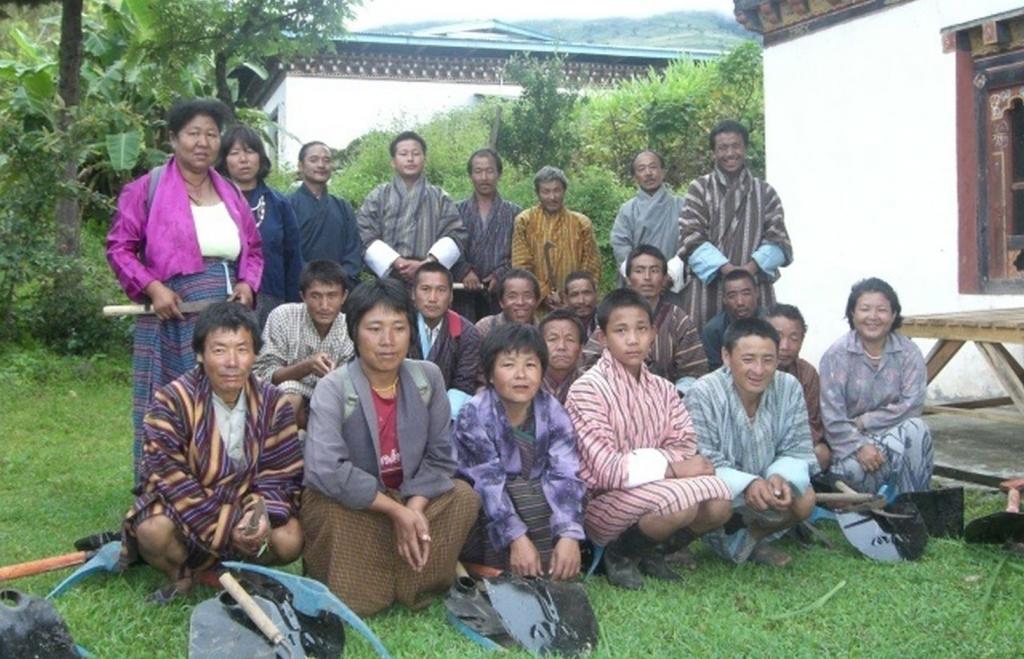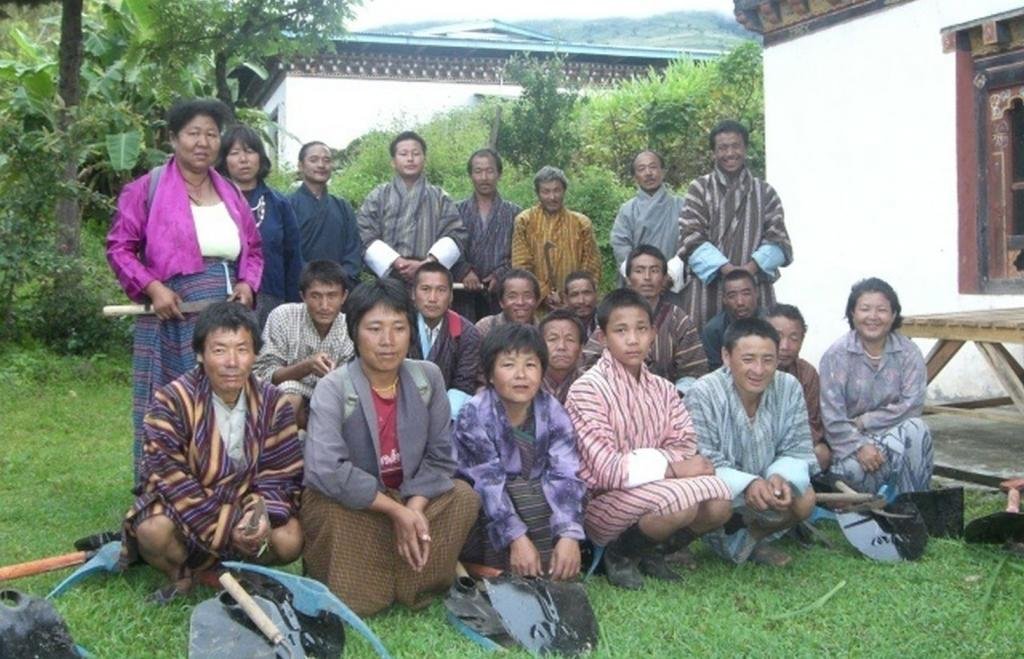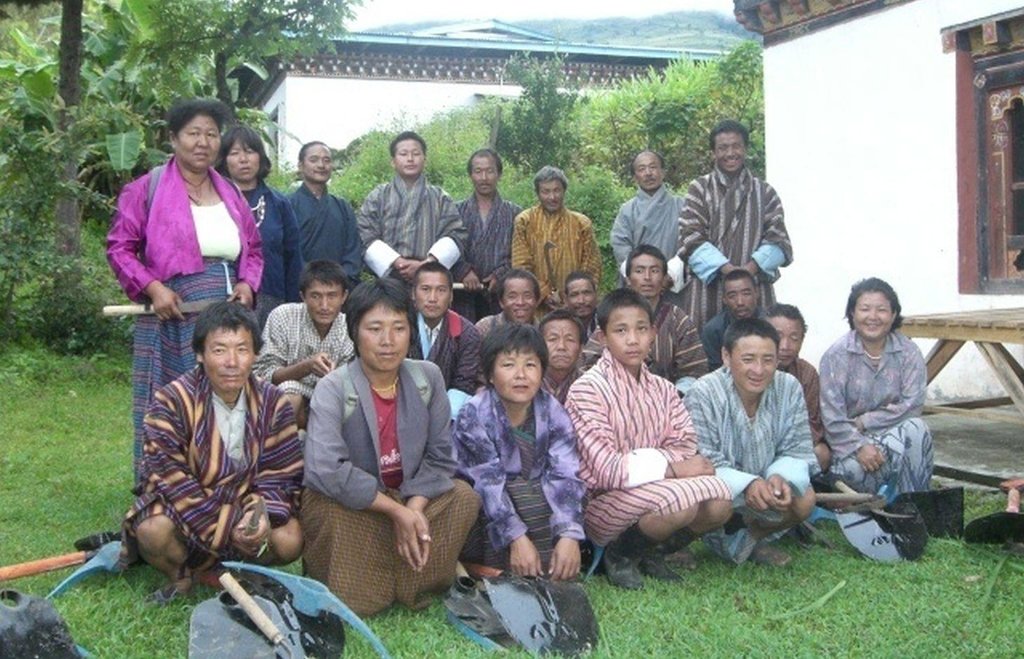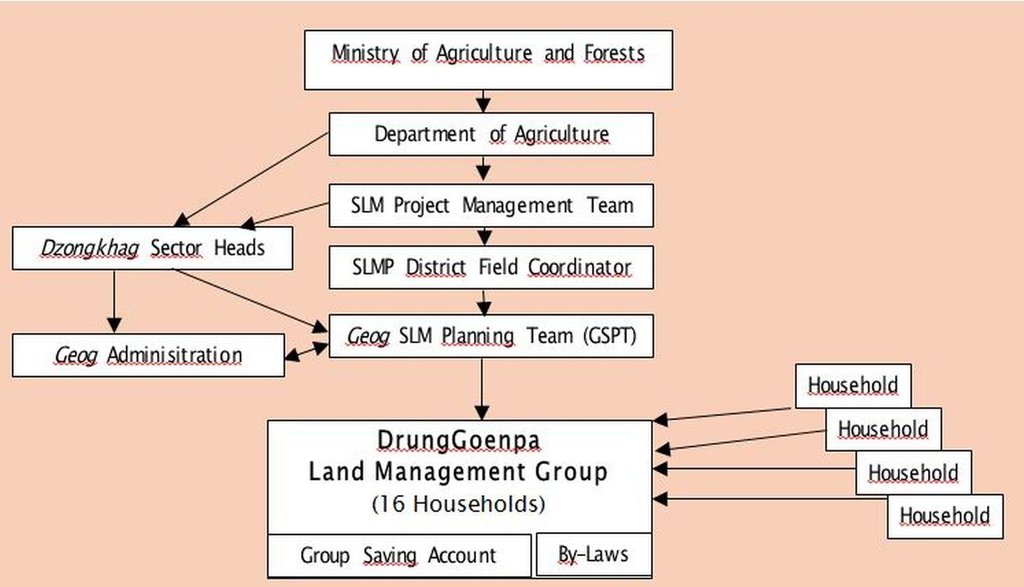Land Management Group [Bután]
- Creación:
- Actualización:
- Compilador: Karma Dorji
- Editor: –
- Revisor: Fabian Ottiger
Phazhing Zinchung Tshogpha (Dzobgkha)
approaches_2493 - Bután
Visualizar secciones
Expandir todo Colapsar todos1. Información general
1.2 Detalles de contacto de las personas de referencia e instituciones involucradas en la evaluación y la documentación del Enfoque
Nombre de la(s) institución(es) que facilitaron la documentación/ evaluación del Enfoque si fuera relevante)
MoA (MoA) - ButánNombre de la(s) institución(es) que facilitaron la documentación/ evaluación del Enfoque si fuera relevante)
National Soil Services Centre (National Soil Services Centre) - Bután1.3 Condiciones referidas al uso de datos documentados mediante WOCAT
¿Cuándo se compilaron los datos (en el campo)?
25/03/2011
El compilador y la/s persona(s) de referencia claves aceptan las condiciones acerca del uso de los datos documentados mediante WOCAT :
Sí
2. Descripción del Enfoque MST
2.1 Breve descripción del Enfoque
Land Management Group uniting all households in a community to plan and implement SLM and cash-generating activities
2.2 Descripción detallada del Enfoque MST
Descripción detallada del Enfoque MST:
Aims / objectives: A Land Management Group (LMG) unites all households of a village and aims to advocate, plan and implement SLM activities, based on the land-based issues of that particular community. The LMG has formal by-laws, drafted interactively with the community, and has its own group saving account, as access to credit and proper savings is still a real constraint in remote areas. A first LMG was started in 2008 in Drunggoenpa chiog in Radhi geog, Trashigang Dzongkhag, East-Bhutan. The idea for the LMG was based on pioneering work of the Renewable Natural Resource Research Centre Bajo, Wangdue Dzongkhag, in Salamji chiog, Dagana Dzongkhag.
Methods: In an effort to reinforce the social cohesion of communities and to improve the efficiency of planning for implementing SLM interventions, SLMP has initiated Land Management Groups. A LMG is considered very useful to overcome one of the main constraints of SLM implementation in Bhutan: labour-shortage. Many individual households have a growing lack of labour and therefore difficulties to implement labour-intensive SLM activities such as terracing, stone bunding or afforestation work.
Stages of implementation: LMGs are especially suitable for smaller communities, where households live relatively close to each other and have a good community bond. Instead of inter-acting with many individual households separately, the extension staff can also target their services, such as training programmes and technical guidance, to the group. The Drunggoenpa LMG was supported in their group formation process with regular meetings and took part in the annual participatory SLM action plan-ning for the chiog, identifying key land-based problems, their causes and possi-ble SLM interventions. Implementation of these SLM activities, such as grass strip establishment, stone check dam construction, group private forest establishment, vegetable production and tree and bamboo plantation, was carried out in a labour-sharing approach. Pooling labour in the group, all the land of the group members is converted or treated.
Role of stakeholders: This enables vulnerable families including single-headed households and the poorest-of-poor, to participate and get access to more labour-intensive SLM interventions. Apart from the pure SLM interventions, attention is given to cash-generating activities such as vegetable production and potato cultivation, to enhance the livelihoods of the farmers.
Other important information: Costs of forming a LMG including implementation of a series of SLM activities at the village level are limited(less than US$2,000 annually).
2.3 Fotos del Enfoque
2.5 País/ región/ lugares donde el Enfoque fue aplicado
País:
Bután
Especifique más el lugar :
Trashigang Dzongkhag, Radhi geog, Drung Goempa Chiog
2.6 Fechas de inicio y conclusión del Enfoque
Indique año del inicio:
2008
Año de conclusión (si el Enfoque ya no se aplica):
2012
2.7 Tipo de Enfoque
- proyecto/ basado en un programa
2.8 Propósitos/ objetivos principales del Enfoque
The Approach focused mainly on SLM with other activities (vegetable production, potato production for cash income generation)
- To overcome labour constraints of labour-intensive SLM activities by working in a group, becoming more time-efficient
- To enhance the community bond and give access to all households to SLM activities
The SLM Approach addressed the following problems: - Severe land degradation in the village through landslides and surface erosion on very steep dryland
- Overgrazing by cattle, causing crop damage and forest degradation
- Lack of timber as result of forest degradation and deforestation
2.9 Condiciones que facilitan o impiden la implementación de la/s Tecnología/s aplicadas bajo el Enfoque
normas y valores sociales/ culturales/ religiosos
- impiden
Labour-intensive SLM activities are potentially excluding vulnerable households from access to SLM support
Treatment through the SLM Approach: Group approach enables the inclusion of all households, making use of labour-sharing
marco de trabajo legal (tenencia de tierra, derechos de uso de tierra y agua)
- facilitan
The existing land ownership, land use rights / water rights greatly helped the approach implementation: All group members own land and this is a great help to implement SLM activities as there is a great sense of ownership.
carga de trabajo, disponibilidad de mano de obra
- impiden
Labour-intensive character of some of the SLM interventions
Treatment through the SLM Approach: Labour-sharing approach in group eases constraint, even for vulnerable and single-headed households
3. Participación y roles de las partes interesadas involucradas
3.1 Partes interesadas involucradas en el Enfoque y sus roles
- usuarios locales de tierras/ comunidades locales
group with local by-laws
No gender bias; women are equally participating in more physically demanding activities, such as ploughing. Yes, little. All community households are participating in the land management group, including some female headed and poorest households.
- especialistas MST/consejeros agrícolas
- gobierno local
Local government (geog and chiog level)
- gobierno nacional (planificadores, autoridades)
Si varias partes interesadas estuvieron involucradas, indique la agencia principal:
Initial idea was developed after field visit by community members and Geog SLM Planning Team (GSPT) to Selamji Land Management group in Dagana Dzongkhag.
3.2 Involucramiento de los usuarios locales de tierras/ comunidades locales en las distintas fases del Enfoque
| Involucramiento de los usuarios locales de tierras/ comunidades locales | Especifique quién se involucró y describa las actividades | |
|---|---|---|
| iniciación/ motivación | interactivo | Community members were inspired by visit to Salamji, a SLM focal village in Dagana Dzongkhag and advocated a similar approach in their village |
| planificación | interactivo | Participatory SLM action planning, annually, to discuss land based issues, causes and potential SLM interventions |
| implementación | interactivo | Range of SLM interventions such as grass strip establishment, stone check dam construction, group private forest plantation etc. technical guidance by local extension staff |
| monitoreo y evaluación | interactivo | Participatory Monitoring & Evaluation meetings with geog extension staff and members of the municipality administration; includes regular insight in group saving account balance and status for transparency |
| Research | ninguno |
3.3 Flujograma (si estuviera disponible)
Descripción:
Organisation chart of the Land Management Group
Autor:
Hans van Noord (Schoutenkamp 43 Heteren The Netherlands)
3.4 La toma de decisiones en la selección de Tecnología(s) MST
Especifique quién decidió la selección de las Tecnología/ Tecnologías a implementarse:
- principalmente usuarios de tierras con el apoyo de especialistas MST
Explique:
.Annual Participatory SLM Action Planning to discuss land-based issue, causes and interventions options and priorities.
Decisions on the method of implementing the SLM Technology were made by mainly by SLM specialists with consultation of land users. Mainly by SLM specialists with consultation of land users; consultation process in context of participatory SLM action planning and participatory monitoring and evaluation meetings.
4. Apoyo técnico, fortalecimiento institucional y gestión del conocimiento
4.1 Construcción de capacidades / capacitación
¿Se proporcionó la capacitación a usuarios de tierras/ otras partes interesadas?
Sí
Especifique quién fue capacitado:
- usuarios de tierras
Forma de capacitación:
- en el contexto de trabajo
- de agricultor a agricultor
- reuniones públicas
Temas avanzados:
Training to community members on group formation and specific technical SLM interventions such as organic vegetable production, grass strip establishment, group private forestry, stone check dam construction, bamboo plantation etc. The annual participatory SLM action planning and natural resource mapping also contributed considerably in raising awareness of all villagers, developing their understanding of causal chain relations of their key land problems.
4.2 Servicio de asesoría
¿Los usuarios de tierras tienen acceso a un servicio de asesoría?
Sí
Especifique si servicio proporcionado se realizó:
- en los campos de los usuarios de tierras
Describa/ comentarios:
Name of method used for advisory service: SLM advisory service by extension staff; Key elements: Grass strip establishment, Group formation, Organic vegatable Production; Renewable Natural Resource Extension staff of the geog are providing on-the-job advisory service to the group members through regular visits to the community to carry out trainings, which are mainly hands-on, with a demonstration site on the land of one of the group members. At the end of the training the group members plan for a rotation schedule to carry out the SLM activity on the land of all group members.
Advisory service is quite adequate to ensure the continuation of land conservation activities; Determination expressed by group to continue with activities post-project.
4.3 Fortalecimiento institucional (desarrollo institucional)
¿Se establecieron o fortalecieron instituciones mediante el Enfoque?
- sí, mucho
Especifique el nivel o los niveles en los que se fortalecieron o establecieron las instituciones:
- local
Especifique el tipo de apoyo:
- construcción de capacidades/ entrenamiento
Proporcione detalles adicionales:
Considerable support to the Land Management Group through group formation process guidance and concentrated effort to plan for and implement a range of SLM focused activities, combined with hands-on training events.
4.4 Monitoreo y evaluación
¿El monitoreo y la evaluación forman parte del Enfoque?
Sí
Comentarios:
bio-physical aspects were regular monitored by project staff, land users through observations; indicators: Regular observations by project staff together with group members of grass strips, riser height, check dam infill and tree seedling growth
technical aspects were regular monitored by project staff, land users through observations; indicators: Regular observations and measurements by project staff together with group members of grass strip area, number of check dams and plantation status (bamboo and tree seedlings)
socio-cultural aspects were regular monitored by project staff, land users through observations; indicators: Regular observations by project staff together with group members on group status and feedback of group on implementation progress and issues and future activities
economic / production aspects were regular monitored by project staff, land users through observations; indicators: Regular observations by project staff together with group on crop yield, fodder grass production along grass strips (# of loads) and animal production increase (milk in litres, butter and cheese in kilos)
area treated aspects were ad hoc monitored by project staff, land users through measurements; indicators: Regular measurement by project staff and group members of area treated with grass strips and area planted with bamboo and tree seedlings
no. of land users involved aspects were ad hoc monitored by project staff, land users through observations; indicators: Ad-hoc observation by group members (attendance register)
management of Approach aspects were regular monitored by project staff, land users through observations; indicators: Regular observations in participatory monitoring and evaluation meetings with group members
There were few changes in the Approach as a result of monitoring and evaluation: In the initial group formation process these was considerable involvement by the local extension staff, which has been reduced as the group members have taken upon themselves most of the planning and implementation as their confidence levels have risen and their technical capability enhanced by a series of training events.
There were few changes in the Technology as a result of monitoring and evaluation
5. Financiamiento y apoyo material externo
5.1 Presupuesto anual para el componente MST del Enfoque
Si no se conoce el presupuesto anual preciso, indique el rango:
- < 2,000
Comentarios (ej. fuentes principales de financiamiento/ donantes principales):
Approach costs were met by the following donors: international (GEF, World Bank): 85.0%; local community / land user(s) (Land Management Group): 15.0%
5.2 Apoyo financiero/material proporcionado a los usuarios de tierras
¿Los usuarios de tierras recibieron financiamiento/ apoyo material para implementar la Tecnología/ Tecnologías? :
Sí
5.3 Subsidios para insumos específicos (incluyendo mano de obra)
- equipo
| Especifique qué insumos se subsidiaron | En qué grado | Especifique los subsidios |
|---|---|---|
| herramientas | parcialmente financiado | |
- agrícola
| Especifique qué insumos se subsidiaron | En qué grado | Especifique los subsidios |
|---|---|---|
| semillas | totalmente financiado | |
| Seedlings | totalmente financiado | |
Si la mano de obra de usuarios de tierras fue un insumo sustancial, ¿fue:
- voluntario?
Comentarios:
Labour contribution to the land management group is in principle voluntary, but for some of the specific SLM interventions SLMP pays the households a fixed amount per area converted or treated with grass strips, planted with bamboo rhizomes etc. These cash payments are an incentive to establish and start certain techniques for which considerable labour is required. All recurrent activities are carried out by the group members.
Tool sets are provided to the group, consisting of hand tools as pickaxe, crowbar and spade. Additionally, seeds and seedlings needed for SLM activities are provided free of cost by SLMP, such as bamboo rhizomes, tree seedlings, fruit tree seedlings, fencing material for the group private forest establishment and temperate grass seed mixture.
5.4 Crédito
¿Se proporcionó crédito bajo el Enfoque para actividades MST?
No
6. Análisis de impacto y comentarios de conclusión
6.1 Impactos del Enfoque
¿El Enfoque ayudó a los usuarios de tierras a implementar y mantener Tecnologías MST?
- No
- Sí, un poco
- Sí, moderadamente
- Sí, mucho
Soil and water conservation efforts have improved considerably with at least o.5 ha of land converted to/treated with SLM, such as grass strips, stone check dams and bamboo and tree plantation areas. A visible impact has been made as the area of grass strips and developing bench terraces are visible for the whole municipality.
¿El Enfoque empoderó a grupos en desventaja social y económica?
- No
- Sí, un poco
- Sí, moderadamente
- Sí, mucho
The most vulnerable household are members of the group, representing the poorest families and female-headed households. Some of the hands-on trainings were carried out on the land of these households to give them first access and overcome their labour shortage constraint.
Did other land users / projects adopt the Approach?
- No
- Sí, un poco
- Sí, moderadamente
- Sí, mucho
Approach has been rolled out to other communities in Trashigang Dzongkhag to scaling-up municipalities of SLMP, based on the experiences with the Drung Goenpa Land Management Group
Did the Approach lead to improved livelihoods / human well-being?
- No
- Sí, un poco
- Sí, moderadamente
- Sí, mucho
Moderate improvement of livelihoods through improved vegetable production (now self-sufficiency and cash generating), stabilization of land degradation, better workability of cropland through grass strip and bench terrace development and improved animal production through improved fodder quality and availability. Also the workload has been reduced by collecting fodder through cut-and-carry near the farm from the grass strips, instead of having to walk far to the forest for fodder collection. The group approach is able to tackle the labour constraint faced previously and includes all vulnerable households.
Did the Approach help to alleviate poverty?
- No
- Sí, un poco
- Sí, moderadamente
- Sí, mucho
Considerable improvement in food self-sufficiency / security by vegetable production and increased yield on cropland treated with grass strips. Also clear improvement of animal production because of fodder improvement with the grass strips providing readily available quality fodder. Potato has now become a cash crop and some households sell vegetables, whereas they had to purchase in the recent past.
6.2 Motivación principal del usuario de la tierra para implementar MST
- producción incrementada
- incremento de la renta(bilidad), proporción mejorada de costo-beneficio
- carga de trabajo reducida
- afiliación al movimiento/ proyecto/ grupo/ redes
- conciencia medioambiental
- well-being and livelihoods improvement
6.3 Sostenibilidad de las actividades del Enfoque
¿Pueden los usuarios de tierras sostener lo que se implementó mediante el Enfoque (sin apoyo externo)?
- incierto
Si respondió no o incierto, especifique y comente:
The group is expected to be able to sustain their activities independently, but a group process is always complex and there are no certainties looking forward. The improved sense of community bonding and mutual trust however is clearly expressed and essential for future sustainability of the group, supported by the existing group saving account, facilitating financial sustainability.
6.4 Fortalezas/ ventajas del Enfoque
| Fuerzas/ ventajas/ oportunidades desde la perspectiva del usuario de la tierra |
|---|
| Are equal.... |
| Fuerzas/ ventajas/ oportunidades desde la perspectiva del compilador o de otra persona de referencia clave |
|---|
|
Enhanced community bond and mutual trust Labour-sharing approach in group eases the difficulty to implement labour-intensive SLM activities Vegetable production in group has improved food security and generates cash income Saving account of group facilitates credit need of households and serves as common bond between households (How to sustain/ enhance this strength: Continued support and guidance to group Continue labour-sharing in future activities Increase production area Regular bookkeeping and cash generating activities to add to savings) |
6.5 Debilidades/ desventajas del Enfoque y formas de sobreponerse a ellos
| Debilidades/ desventajas/ riesgos desde la perspectiva del usuario de la tierra | ¿Cómo sobreponerse a ellas? |
|---|---|
| Are equal... |
| Debilidades/ desventajas/ riesgos desde la perspectiva del compilador o de otra persona de referencia clave | ¿Cómo sobreponerse a ellas? |
|---|---|
|
Initially freely grazing cattle caused problems between group members with implementation of SLM activities Group expresses interest in having a simple meeting venue to facilitate group meetings |
By-laws help to overcome issues and working together in a group has improved mutual trust Seek support to construct simple meeting hall |
7. Referencias y vínculos
7.1 Métodos/ fuentes de información
- visitas de campo, encuestas de campo
- entrevistas con usuarios de tierras
Vínculos y módulos
Expandir todo Colapsar todosVínculos
No hay vínculos
Módulos
No se hallaron módulos






